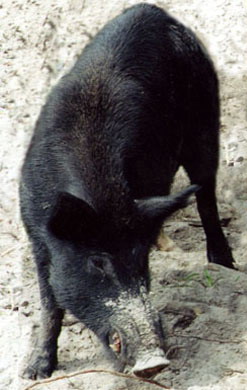Wild pigs (Sus scrofa) include both feral (domestic animals that have escaped captivity) hogs and what people commonly refer to as “wild boar,” a native to Eurasia but introduced to North America to interbreed with feral hogs. Feral hogs include first-generation escapees as well as all subsequent production, which comprises the overwhelming bulk of the U.S. free-ranging hog population. Together, they can all be lumped into the category of “feral hogs.” Like domestic hogs, feral hogs may be any color. Their size and conformation depend on the breed, degree of hybridization with wild boar, and level of nutrition during their growing period. More often that not, feral hogs tend to be brown, black, or a variation or combination of both.
Introduced wild boar have longer legs and larger heads with longer snouts than run-of the-mill feral hogs. The color of young boar is generally reddish brown with black longitudinal “watermelon” stripes. As the young develop, the stripes begin to disappear and the red changes to brown and finally to black. Both the male feral hog and wild boar have continuously growing tusks. Wild boar and feral hogs hybridize freely. As a result, the term wld pig, wild hog, or feral hog is appropriate as a generic term for these animals.
